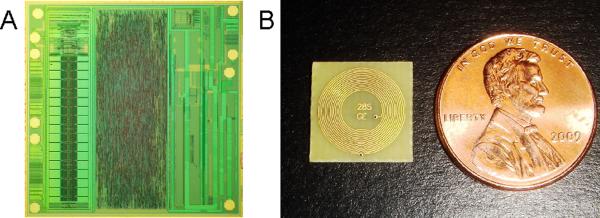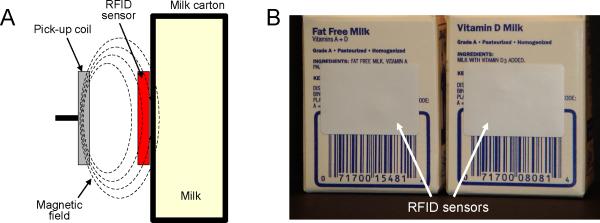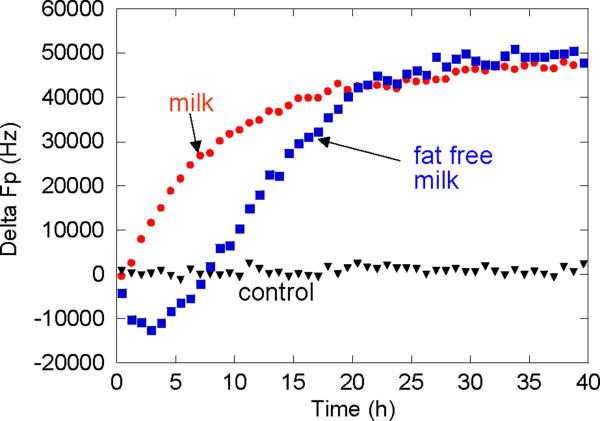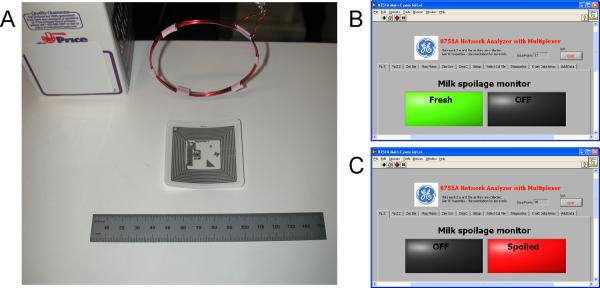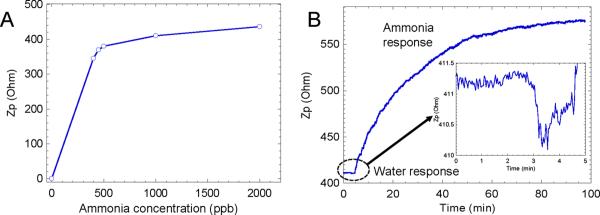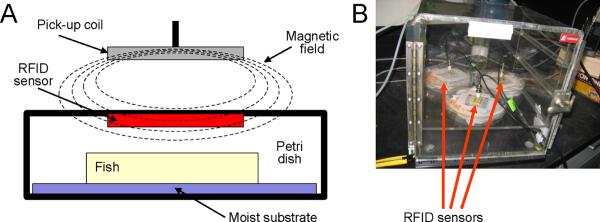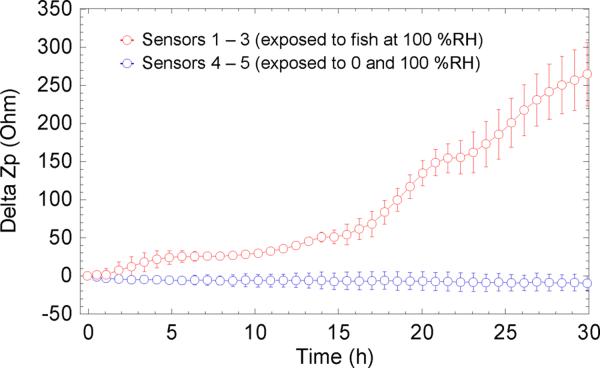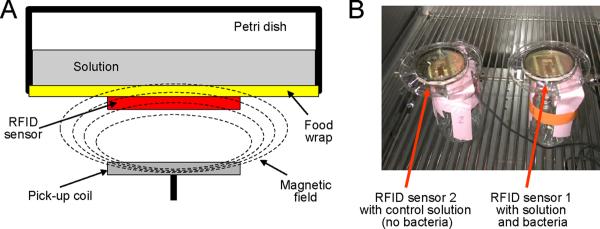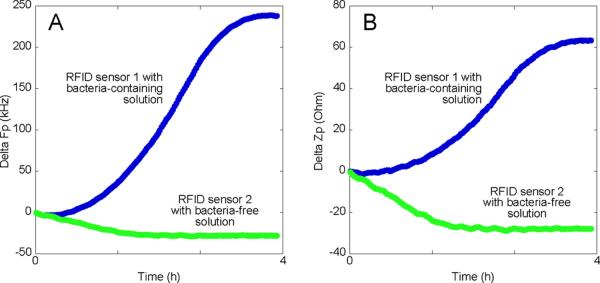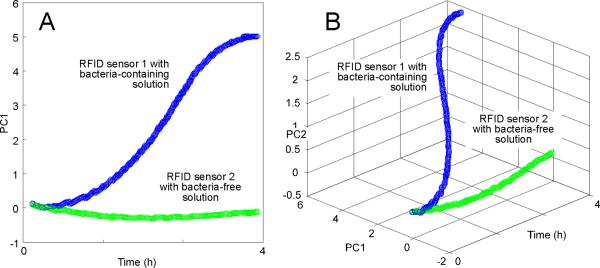Abstract
The market demands for new sensors for food quality and safety stimulate the development of new sensing technologies that can provide an unobtrusive sensor form factor, battery-free operation, and minimal sensor cost. Intelligent labeling of food products to indicate and report their freshness and other conditions is one of important possible applications of such new sensors. We have applied passive (battery-free) radio frequency identification (RFID) sensors for highly sensitive and selective detection of food freshness and bacterial growth. In these sensors, the electric field generated in the RFID sensor antenna extends out from the plane of the RFID sensor and is affected by the ambient environment providing the opportunity for sensing. This environment may be in the form of a food sample within the electric field of the sensing region or a sensing film deposited onto the sensor antenna. Examples of applications include monitoring of freshness of milk, freshness of fish, and bacterial growth in a solution. Unlike other food freshness monitoring approaches that require a thin film battery for operation of an RFID sensor and fabrication of custom-made sensors, our developed passive RFID sensing approach combines advantages of both battery-free and cost-effective sensor design and offers response selectivity that is impossible to achieve with other individual sensors.
Keywords: passive RFID sensors, multivariate data analysis, food safety, food freshness, bacteria detection, bacerial growth, milk, fish, E. Coli
Introduction
Radio frequency identification (RFID) sensors are finding their diverse applications when an unobtrusive sensor form factor, battery-free design, and minimal sensor cost are the top three requirements for a new sensor. Examples of diverse applications include pharmaceutical, warehousing, agricultural, industrial, food safety, and security.1,2 Benefits of RFID sensors for food quality and safety, as compared to tethered sensors, include the non-obtrusive nature of their installations, higher nodal densities, and lower installation costs without the need for extensive wiring.3–5 In addition, a significant advantage of RFID6 and other electronic sensors7–12 over optical sensors13–15 is in the ability to perform measurements through non-transparent packaging.
There are several developed battery-free wireless sensing technologies based on magnetoelastic,16 thickness shear mode,17–19 surface acoustic wave,20,21 magnetic acoustic resonance,22,23 and resonant LCR (inductor-capacitor-resistor)7,24 transducers. Several approaches for battery-free RFID sensing have been explored, e.g. based on chipless RFID sensors.12,25,26
We recently developed a methodology to implement passive RFID tags for physical, chemical, and biological sensing.5,27–35 In our RFID sensing approach, the resonance impedance spectrum of the sensor antenna is measured and further correlated with chemical, biological, or physical properties of the environment. This correlation is performed using multivariable response of the RFID sensor computed from the measured impedance spectrum.
The complementary driving forces in successful sensor development are innovative ideas and the market size for new sensors. The market size is often but not always is supported by the regulatory requirements. If both driving forces are strong, the sensor development moves from its initial proof-of-concept technology readiness level to the commercialization of the sensor technology.5
The sizes of markets for food safety testing products ($0.25 B) and pathogen detecting sensors ($0.5 B)36 and provide exciting opportunities for the development of new sensing technologies for food quality and safety. Intelligent labeling of food products to indicate and report their freshness and other conditions is one of important possible applications of the developed RFID sensors. Unlike other food freshness monitoring approaches that require a thin film battery for operation of an RFID sensor6 and fabrication of custom-made sensors,8,10,37 our developed passive RFID sensing approach combines advantages of both battery-free and cost-effective sensor design and offers response selectivity that is impossible to achieve with other individual sensors.27,29,31
In this review, we summarize result on the development of RFID sensors for food quality and safety. In these sensors, the electric field generated in the RFID sensor antenna extends out from the plane of the RFID sensor and is affected by the ambient environment providing the opportunity for sensing. This environment may be in the form of a food sample within the electric field of the sensing region or a sensing film deposited onto the sensor antenna. Examples of applications include monitoring of freshness of milk, freshness of fish, and bacterial growth.
General principles of design and operation of RFID food sensors
In order to assess the broad applicability of the developed sensors for food safety applications, it is critical to understand the general principles of their design and operation (see Figure 1). The equivalent circuit of the developed sensors forms an inductor-capacitor-resistor (LCR) circuit and is described by the inductance LA, capacitance CA, and resistance RA of the sensing antenna coil, capacitance CS and resistance RS of the sensing region, and capacitance CC and resistance RC of the integrated circuit (IC) chip (see Figure 1A). Reading and writing of digital information into the RFID sensor and measurement of impedance of the RFID sensor antenna are performed via mutual inductance coupling between the RFID sensor antenna and the pickup coil of a digital/analog sensor reader.
Figure 1.
Operation principle of developed passive RFID sensors. (A) Sensor equivalent circuit described by the inductance LA, capacitance CA, and resistance RA of the sensing antenna coil, capacitance CS and resistance RS of the sensing region, and capacitance CC and resistance RC of the IC chip. (B) Schematic representation of the origin of response of RFID sensors to parameters of interest. (C) Measured impedance spectrum (real part and imaginary part of impedance) and examples of parameters for multivariate analysis (see text for details).
Impedance spectra Ž(f) of the sensor are measured using a laboratory or a portable network analyzer component and digital data from an IC chip is measured with a digital RFID reader component29 of our custom sensor reader. Digital data include sensor calibrations, food manufacturing data, end-user data, etc. The network analyzers are used to scan the frequencies over the range of interest (typically centered at 13 MHz with a scan range of ~10 MHz).
The electric field generated in the RFID sensor antenna extends out from the plane of the RFID sensor (Figure 1B) and is affected by the ambient environment providing the opportunity for sensing. This environment may be in the form of a food sample within the electric field of the sensing region or a sensing film deposited onto the sensor antenna. In both cases, the impedance of the antenna circuit Ž(f) is modulated through the changes in capacitance CS and resistance RS of the sensing region. This sensing region can be in the form of a full antenna or a complementary region in contact with the antenna.32 Numerous types of sensing materials applicable for the food quality sensing were recently analyzed.5
To achieve accurate and precise measurements using our sensors, we measure the real Zre(f) and imaginary Zim(f) parts of the impedance spectra Ž(f) and calculate several spectral parameters. A schematic representation of the real Zre(f) and imaginary Zim(f) parts of the impedance spectrum Ž(f) of the sensor without possible effects from a pick up coil is illustrated in Figure 1C. Several calculated spectral parameters include the frequency position Fp and magnitude Zp of Zre(f) and the resonant F1 and antiresonant F2 frequencies of Zim(f). Additional parameters can also be calculated (impedance magnitudes Z1 and Z2 at F1 and F2 frequencies, respectively, zero-reactance frequency, quality factor, etc). From the measured parameters, resistance, capacitance, and other parameters of the resonant antenna can be also determined. Figure 2 shows examples of RFID sensors applied in our studies for food quality and safety.
Figure 2.
Examples of employed RFID sensors based on (A) Texas Instruments RFID tag, (B) Avery Dennison RFID tag, (C) TagSys RFID tag.
Uncontrolled temperature fluctuations produce independent effects on the different components of the equivalent circuit. These independent effects are correlated with the spectral features of the resonance impedance spectra and are resolved by the multivariable response of the sensor.33,38
For scenarios when the food is irradiated by ionizing radiation as a food safety measure to destroy bacteria, pathogens, and pests,39,40 conventional RFID IC memory chips do not survive the applied radiation dose that can be up to 30 kGy. We have developed a technical solution to solve this problem where an IC chip is based on the Ferroelectric Random Access Memory (FRAM) technology and provides reliable gamma-resistant RFID tags and sensors.41 The FRAM memory chips have 2000 bytes of user memory (MB89R118A, Fujitsu Microelectronics Ltd, Japan)42 and are made using a standard RF signal modulation circuitry fabricated using a 0.35-μm complementary metal-oxide semiconductor (CMOS) process and a non-volatile FRAM memory.43 A photo of this IC chip is shown in Figure 3A while one of our RFID sensors with such an IC chip is shown in Figure 3B.
Figure 3.
Photographs of (A) FRAM IC memory chip MB89R118A and (B) Developed RFID sensor for gamma-sterilizable applications. Sensor diameter = 10 mm.
Examples of applications
Monitoring of milk freshness
Milk is a major component of diverse diets across the world and has been the supply source, especially in the developing world, of a wide range of nutrients.44 Milk spoilage is a result of growth of micro-organisms that modifies the composition of the medium with the metabolic products, changes the ionic content and conductivity of milk.45 Hence, determination of milk quality is critical in order to maintain food safety and human health. Measured dielectric and viscosity parameters of milk have been successfully related to the milk freshness and milk adulteration.10,44,46–48 Noninvasive and noncontact determination of milk quality attracts significant research and commercial interest.10,37,46
Our RFID sensors for monitoring of freshness of milk were constructed using 23 × 38 mm RFID tags from Texas Instruments (Plano, TX). Changes in the dielectric properties of milk were sensed with these RFID sensors that had an adhesive backing that has been attached to the side wall of the milk cartons. Figure 4A illustrates a schematic of the sensor positioning on milk carton and sensor-response readout with a pick-up coil. Two types of milk were used for evaluation, fat-free milk and whole milk. Before the RFID sensing experiment, reference measurements of the dielectric properties of fresh and spoiled milk were performed.
Figure 4.
RFID sensor layout for demonstration of determination of milk freshness. (A) Schematic of sensor positioning onto a milk carton and sensor-response readout with a pick-up coil. (B) Photo of milk cartons with attached RFID sensors.
To determine milk spoilage rate, which is related to the changes in the dielectric properties of milk during storage, non-invasive determinations with RFID sensors were done directly through the walls of original milk cartons. Figure 4B depicts a photo of milk cartons with attached RFID sensors and demonstrates the simplicity of this sensing technology. A control experiment was performed with an RFID sensor attached to a carton filled with water that was identical to that filled with milk. Sensors monitored the change in solution dielectric constant as a function of storage time by taking advantage of the electromagnetic field penetration depth out of plane relative to the sensors and performing analysis directly through the original thin wall of the milk cartons.
Results of real time non-invasive monitoring of the condition of the two types of milk in cartons and the control water sample at room temperature are presented in Figure 5. The data illustrates different rates of spoilage of whole and fat free milk and no signal change for the control RFID sensor. The change in Fp signal of the RFID sensor due to changes in the dielectric property of milk was indicative of milk spoilage and was correlated with results obtained from the reference measurements, before and after milk spoilage. We also observed a small drop in the sensor response during an initial stage of milk monitoring. This behavior was observed in the past with impedance probes inserted in milk45,49 and was attributed to being the result of several competing mechanisms of milk spoilage.
Figure 5.
Non-invasive monitoring of whole and fat-free milk using disposable RFID sensors. Response of RFID sensors to spoilage of two types of milk and to a control (water) sample29.
Automatic determinations of milk freshness were further performed (see Figure 6). For these measurements, 47 × 47 mm RFID tags from Texas Instruments (Plano, TX) were employed. Measurements of the resonant properties of the sensors were initially performed manually at different sensor positions relative to the pick-up coil. Further, a program, written in LabVIEW automatically determined the resonant properties of the sensors without the positioning effects of sensors relative to the pick-up coil and discriminated between cartons with fresh and spoiled milk.
Figure 6.
Automatic non-invasive determination of milk freshness. (A) A milk carton with an attached RFID sensor and an associated pick-up coil. (B, C). Front panel of written program for an automatic determination of the resonant properties of the sensors without the positioning effects of sensors relative to the pick-up coil. The program was able to discriminate between cartons with fresh and spoiled milk.
Monitoring of fish condition
Using RFID sensors, food freshness can be determined not only by monitoring of changes in dielectric properties of individual food items, but also by adding enhanced functionality through the use of specific sensing materials as components of the sensors. By using such sensing materials, detection of food spoilage can be performed on a much shorter time scale. Detection of volatiles from food is a well-established method for determination of food freshness and spoilage.50 The use of high-end laboratory instrumentation provides new insights on the evolution of diverse individual volatiles during food storage and determines food freshness and spoilage “markers”.50,51 These markers can be monitored using sensor arrays (electronic noses)52–56 or using more non-obtrusive and ubiquitous devices.5,8,12 These monitoring devices can become a part of smart packaging15,57 or can be smart food labels.12
Determination of fish freshness and spoilage based on measurements of characteristic odor volatiles is one of the main directions of the development of smart packaging because of the significant demand and market value of different fish products.50 Volatiles contributing to odor of newly caught fresh fish originate from the diverse microflora and include C6 – C9 alcohols and carbonyl compounds, while volatiles that contribute to odor of fish during spoilage include ethanol, trimethylamine, ammonia, hydrogen sulphide, and some others which are the results of microbial spoilage.50 Volatiles responsible for the fishy odor are the result of bacterial metabolism and include ammonia and volatile amines known as total volatile basic nitrogen (TVB-N) compounds.57 Sensitive and selective detection of the TVB-N compounds is an active area of research.57–61
RFID sensors for monitoring of fish freshness were constructed from available 47 × 47 mm, RFID tags from Avery Dennison (model AD 709, Flowery Branch, Georgia) by draw-coating a polyaniline polymer to form a sensing film onto the antenna. Polyaniline is one of conjugated polymers also known as intrinsically conducting polymers. Conjugated polymers exhibit several mechanisms of molecular gas recognition including changes in density and charge carrier mobility, polymer swelling, and conformational transitions of polymer chains.62,63 The strong acid-base interactions between the TVB-N compounds and the polyaniline polymeric film produce strong change in the film conductivity and lead to the high sensor sensitivity.
Initially, these RFID sensors were tested for the detection of ammonia gas and demonstrated a 500 part-per-trillion (ppt) detection limit (see Figure 7A). This achieved low detection limit was very attractive for the application of these sensors for the monitoring of fish freshness.5 Further, the formulation of the polyaniline-based sensing film was optimized to minimize effects of water vapor (see Figure 7B). This reduced sensitivity to water vapor was possible due to the strong irreversible deprotonation chemical reaction of polyaniline in the presence of ammonia and only weak hydrogen bonding reversible interactions with water vapor.
Figure 7.
Demonstration of high sensitivity and selectivity of developed RFID sensors for fish freshness. (A) Calibration curve of RFID sensor for ammonia detection. (B) Response of the sensor to water vapor (~ 75% relative humidity) and to 500 ppb of ammonia.
For the evaluation of response of RFID sensors to fish odor during storage, five RFID sensors were arranged in separate petri dishes with ~ 200-mL headspace and were monitored at once using a multiplexed sensor reader. Three petri dishes contained individual ~ 20 g samples of salmon filet on a water-soaked liner. Two other sensors served as negative controls. The first control sensor was in a dry petri dish. The second control sensor was in a petri dish that contained only a water-soaked liner. Sensor positioning into the headspace of the petri dish with the fish sample and sensor-response readout with a pick-up coil are illustrated in Figure 8.
Figure 8.
RFID sensor layout for demonstration of monitoring of fish freshness. (A) Schematic of sensor positioning into the headspace of a plastic container with a fish sample and sensor-response readout with a pick-up coil. (B) Photo of RFID sensors attached to plastic containers with fish samples.
Results of experiments monitoring fish freshness at room temperature are presented in Figure 9. The negative control sensors exposed to low humidity and 100 %RH conditions demonstrated no increase in sensor impedance. Amines that were generated during salmon storage produced a significant increase in sensor impedance due to the deprotonation of polyaniline as detected in ~ 2 h with these sensors. Optical sensors based on colorimetric pH reagents immobilized onto solid sensing films also have been used for detection of ammonia and amines, however with higher detection limits (mid-range ppb or higher)57,59,64–66 as compared to the 500-ppt detection limit achieved with our developed RFID sensors.
Figure 9.
Monitoring of fish freshness using polyaniline-based RFID sensors. Sensors 1 – 3 were positioned into the headspace of a petri dish with individual ~ 20 g samples of salmon filet on a water-soaked liner. Sensor 4 served as the first negative control positioned in a low humidity headspace. Sensor 5 served as the second negative control positioned in a headspace only with a water-soaked liner. Sensors 1 – 5 were monitored simultaneously at room temperature using a sensor multiplexer after 1 h of equilibration time to reach the state-state condition in all sensors. Results are plotted as means and SD for sensors 1 – 3 (red trace) and 4 – 5 (blue trace)5.
Direct monitoring of bacteria growth
Direct monitoring of bacterial growth is important for food safety applications. Traditionally, quantitation of bacterial contamination is performed using automated bacterial counting and based on analysis of markers of bacterial metabolism.67,68 Additionally, detection of bacteria has been carried out using sensors and sensor arrays.69,70 Sensitive and selective detection of bacteria and its growth in a non-invasive, non-obtrusive non-contact fashion using wireless or proximity sensors is currently an active area of research.12,71,72
We have demonstrated the applicability of developed RFID sensors for monitoring of bacterial growth using E. coli as a model system. Monitoring of bacteria was performed using 23 × 38 mm RFID tags from Texas Instruments (Plano, TX). These tags were employed as RFID sensors by measurements the resonance impedance of the antenna circuit. Two RFID sensors were positioned into petri dishes and were kept in an incubator at 37 °C. The RFID sensors were integrated with a food wrap film as detailed in Figure 10A. Each sensor was attached with its original adhesive to one side of the food wrap film while the other side of the food wrap film was exposed to a solution. One of the RFID sensors (sensor 1) was associated with a solution containing E. coli, while another sensor (sensor 2) was associated with a sterile, bacteria-free solution. Reading of the resonance impedance of the sensors was performed using a pickup coil from the bottom of the petri dish and RFID sensor as shown in Figure 10A. A photo of sensor 1 (with E. coli-containing solution) and sensor 2 (with control bacteria-free sterile solution) in the incubator is shown in Figure 10B. An initial ~ 1.5 h time period (not shown) was a stabilization period where responses of sensors 1 and 2 equilibrated. This initial time may be associated with the equilibration of liquid distribution between the solution and the food wrap.
Figure 10.
RFID sensor layout for demonstration of monitoring of bacterial growth. (A) Schematic of sensor positioning into a plastic container. (B) Photo of two RFID sensors in the incubator for demonstration of monitoring of bacterial growth.
Upon the equilibration, the sensor 1 started to demonstrate an increase in the sensor signal while the response of the control sensor 2 remained stable. Figure 11 illustrates representative ΔFp and ΔZp results of this experiment. The increase in the response of sensor 1 was associated with the change in the dielectric contact of the food wrap layer due to the accumulation of bacteria in the sensing region, while the constant response of sensor 2 was associated with no change in the dielectric contact of the food wrap layer due to the exposure to the sterile solution.
Figure 11.
Real-time monitoring results using two RFID sensors. Sensor 1 was with a solution containing E. coli bacteria; Sensor 2 was with a sterile bacteria-free solution. (A) and (B) are representative results of ΔFp and ΔZp responses, respectively.
Responses of sensor 1 and sensor 2 were further analyzed using a pattern recognition technique to quantitatively determine the differences in the responses between sensors exposed to bacteria and to sterile conditions. As a pattern recognition technique, we employed principal components analysis (PCA), a robust unsupervised pattern recognition tool.73 PCA is a multivariate data analysis tool that projects the data set onto a subspace of lower dimensionality with removed collinearity. PCA achieves this objective by explaining the variance of the data matrix in terms of the weighted sums of the original variables Fp, F1, F2, and Zp or complete Zre(f) and Zim(f) of impedance spectra with no significant loss of information. These weighted sums of the original variables are called principal components (PCs). Results of PCA are presented in Figure 12 illustrating that the RFID sensors provided the robust ability to discriminate between bacterial growth and sterile conditions.
Figure 12.
Results of pattern recognition analysis of a bacterial monitoring process demonstrating pattern discrimination between RFID sensors responses in the presence (sensor 1) and absence (sensor 2) of E. coli bacteria. (A) Results of PC1 response vs. time. (B) Results of PC1 response vs. PC2 response vs. time.
Future developments
This study demonstrated the applicability of our RFID sensors for the monitoring different aspects of food quality including freshness, ageing, and spoilage. In contrast to known wireless sensors, our developed RFID sensors combine several measured parameters from the resonant sensor antenna with multivariate data analysis and deliver unique capability of sensing with rejection of environmental interferences with a single sensor. Similar to our other RFID sensors that have the ability for self-correction for temperature effects,38,74 our bacterial RFID sensors reported here also have this self-correction ability for temperature instabilities. Overall, to be accepted for diverse practical application scenarios, RFID sensors should have the ability for the self-calibration and for the self-correction for variable ambient conditions (temperature, repositioning, and others). Future steps are being planned for field-testing of these sensors in numerous conditions.
The application of battery free (passive) 13.56 MHz RFID tags as wireless or proximity sensors is attractive where the high quality of sensor performance is needed at low cost and when battery-free operation is critical. Our sensors, when integrated into single-use packaging components can provide several important capabilities previously unavailable from other single-use sensing technologies: (1) common sensor platform for measurements of physical, chemical, and biological parameters, (2) multi-parameter monitoring with individual sensors, and (3) simultaneous digital identification functionality that provides information about the packaging component and the calibration coefficients of the RFID sensor.
Acknowledgements
We thank Fujitsu Microelectronics Ltd, Japan for providing FRAM memory chips MB89R118A for fabrication of our RFID sensors and image shown in Figure 3A. This work has been funded in part from National Institute of Environmental Health Sciences (Grant 1R01ES016569-01A1) and from General Electric's fundamental research funds.
References
- (1).Finkenzeller K. RFID Handbook. Fundamentals and applications in contactless smart cards and identification. 2 ed. Wiley; Hoboken, NJ: 2003. [Google Scholar]
- (2).Lehpamer H. RFID Design Principles. Artech House; Norwood, MA: 2008. [Google Scholar]
- (3).Iddan G, Meron G, Glukhovsky A, Swain P. Wireless capsule endoscopy. Nature. 2000;405:417–417. doi: 10.1038/35013140. [DOI] [PubMed] [Google Scholar]
- (4).Messer H, Zinevich A, Alpert P. Environmental Monitoring by Wireless Communication Networks. Science. 2006;312:713–713. doi: 10.1126/science.1120034. [DOI] [PubMed] [Google Scholar]
- (5).Potyrailo RA, Surman C, Nagraj NN, Burns A. Materials and Transducers Toward Selective Wireless Gas Sensing. Chem. Rev. 2011;111:7315–7354. doi: 10.1021/cr2000477. [DOI] [PMC free article] [PubMed] [Google Scholar]
- (6).Gundlach DJ. Organic electronics: Low power, high impact. Nature Materials. 2007;6:173–174. doi: 10.1038/nmat1856. [DOI] [PubMed] [Google Scholar]
- (7).Ong KG, Grimes CA. A resonant printed-circuit sensor for remote query monitoring of environmental parameters. Smart Mater. Struct. 2000;9:421–428. [Google Scholar]
- (8).Tan EL, Ng WN, Shao R, Pereles BD, Ong KG. A wireless, passive sensor for quantifying packaged food quality. Sensors. 2007;7:1747–1756. doi: 10.3390/s7091747. [DOI] [PMC free article] [PubMed] [Google Scholar]
- (9).Lange U, Roznyatovskaya NV, Mirsky VM. Conducting polymers in chemical sensors and arrays. Anal. Chim. Acta. 2008;614:1–26. doi: 10.1016/j.aca.2008.02.068. [DOI] [PubMed] [Google Scholar]
- (10).Huang S, Ge S, He L, Cai Q, Grimes CA. A remote-query sensor for predictive indication of milk spoilage. Biosens. Bioelectron. 2008;23:1745–1748. doi: 10.1016/j.bios.2008.01.036. [DOI] [PubMed] [Google Scholar]
- (11).Hossain ME, Rahman GMA, Freund MS, Jayas DS, White NDG, Shafai C, Thomson DJ. Fabrication and optimization of a conducting polymer sensor array using stored grain model volatiles. J. Agric. Food Chem. 2012;60:2863–2873. doi: 10.1021/jf204631q. [DOI] [PubMed] [Google Scholar]
- (12).Tao H, Brenckle MA, Yang M, Zhang J, Liu M, Siebert SM, Averitt RD, Mannoor MS, McAlpine MC, Rogers JA, Kaplan DL, Omenetto FG. Silk-based conformal, adhesive, edible food sensors. Adv. Mater. 2012;24:1067–1072. doi: 10.1002/adma.201103814. [DOI] [PubMed] [Google Scholar]
- (13).Mills A. Oxygen indicators and intelligent inks for packaging food. Chem. Soc. Rev. 2005;34:1003–1011. doi: 10.1039/b503997p. [DOI] [PubMed] [Google Scholar]
- (14).Zhang C, Suslick KS. Colorimetric sensor array for soft drink analysis. J. Agric. Food Chem. 2007;55:237–242. doi: 10.1021/jf0624695. [DOI] [PubMed] [Google Scholar]
- (15).Kuswandi B, Wicaksono Y, Jayus, Abdullah A, Heng LY, Ahmad M. Smart packaging: Sensors for monitoring of food quality and safety. Sensing and Instrumentation for Food Quality and Safety. 2011;5:137–146. [Google Scholar]
- (16).Zeng K, Grimes CA. Wireless Magnetoelastic Physical, Chemical, and Biological Sensors. IEEE Trans. Magnetics. 2007;43:2358–2363. [Google Scholar]
- (17).Ogi H, Motoshisa K, Matsumoto T, Hatanaka K, Hirao M. Isolated electrodeless high-frequency quartz crystal microbalance for immunosensors. Anal. Chem. 2006;78:6903–6909. doi: 10.1021/ac061004a. [DOI] [PubMed] [Google Scholar]
- (18).Morris WG, Potyrailo RA. Wireless Sensor Array System for Combinatorial Screening of Sensor Materials. MRS Symp. Proc. 2006;894:219–224. [Google Scholar]
- (19).Potyrailo RA, Morris WG. Wireless resonant sensor array for high-throughput screening of materials. Rev. Sci. Instrum. 2007;78:072214. doi: 10.1063/1.2755657. [DOI] [PubMed] [Google Scholar]
- (20).Reindl L, Scholl G, Ostertag T, Ruppel CCW, Bulst W-E, Seifert F. SAW Devices as Wireless Passive Sensors. IEEE Ultrasonics Symp. 1996:363–367. [Google Scholar]
- (21).Pohl A. A Review of Wireless SAW sensors. IEEE Trans. Ultrason. Ferroelectr. Freq. Control. 2000;47:317–332. doi: 10.1109/58.827416. [DOI] [PubMed] [Google Scholar]
- (22).Ogi H, Ledbetter H, Kim S, Hirao M. Contactless mode-selective resonance ultrasound spectroscopy: Electromagnetic acoustic resonance. J. Acoust. Soc. Am. 1999;106:660–665. [Google Scholar]
- (23).Stevenson AC, Lowe CR. Magnetic-acoustic-resonator sensors (MARS): A new sensing methodology. Sens. Actuators A. 1999;72:32–37. [Google Scholar]
- (24).Birdsell E, Allen MG. Wireless chemical sensors for high temperature environments. Solid-State Sensors, Actuators, and Microsystems Workshop; Hilton Head Island, South Carolina. June 4–8 2006.pp. 212–215. [Google Scholar]
- (25).Fletcher R, Levitan JA, Rosenberg J, Gershenfeld N. Application of smart materials to wireless ID tags and remote sensors. MRS Symp. Proc. 1997;459:557–562. [Google Scholar]
- (26).Shrestha S, Balachandran M, Agarwal M, Phoha VV, Varahramyan K. A chipless RFID sensor system for cyber centric monitoring applications. IEEE Trans. Microw. Theory. 2009;57:1303–1309. [Google Scholar]
- (27).Potyrailo RA, Morris WG. Multianalyte Chemical Identification and Quantitation Using a Single Radio Frequency Identification Sensor. Anal. Chem. 2007;79:45–51. doi: 10.1021/ac061748o. [DOI] [PubMed] [Google Scholar]
- (28).Potyrailo RA, Mouquin H, Morris WG. Position-independent chemical quantitation with passive 13.56-MHz radio frequency identification (RFID) sensors. Talanta. 2008;75:624–628. doi: 10.1016/j.talanta.2007.06.023. [DOI] [PubMed] [Google Scholar]
- (29).Potyrailo RA, Morris WG, Sivavec T, Tomlinson HW, Klensmeden S, Lindh K. RFID Sensors Based on Ubiquitous Passive 13.56-MHz RFID Tags and Complex Impedance Detection. Wirel. Commun. Mob. Comput. 2009;9:1318–1330. [Google Scholar]
- (30).Potyrailo RA, Surman C, Morris WG. Combinatorial screening of polymeric sensing materials using RFID sensors: combined effects of plasticizers and temperature. J. Comb. Chem. 2009;11:598–603. doi: 10.1021/cc900001n. [DOI] [PubMed] [Google Scholar]
- (31).Potyrailo RA, Surman C, Go S, Lee Y, Sivavec T, Morris WG. Development of radio-frequency identification sensors based on organic electronic sensing materials for selective detection of toxic vapors. J. Appl. Phys. 2009;106:124902. [Google Scholar]
- (32).Potyrailo RA, Surman C, Morris WG, Go S, Lee Y, Cella JA, Chichak KS. Selective quantitation of vapors and their mixtures using individual passive multivariable RFID sensors. IEEE International Conference on RFID, IEEE RFID. 2010:22–28. [Google Scholar]
- (33).Potyrailo RA, Wortley T, Surman C, Monk D, Morris WG, Vincent M, Diana R, Pizzi V, Carter J, Gach G, Klensmeden S, Ehring H. Passive multivariable temperature and conductivity RFID sensors for single-use biopharmaceutical manufacturing components. Biotechnol. Prog. 2011;27:875–884. doi: 10.1002/btpr.586. [DOI] [PubMed] [Google Scholar]
- (34).Potyrailo RA, Surman C, Monk D, Morris WG, Wortley T, Vincent M, Diana R, Pizzi V, Carter J, Gach G, Klensmeden S, Ehring H. RFID sensors as The Common Sensing Platform for Single-use Biopharmaceutical Manufacturing. Means. Sci. Tech. 2011;22 doi: 10.1002/btpr.586. art. no 0820001. [DOI] [PubMed] [Google Scholar]
- (35).Potyrailo RA, Burns A, Surman C, Lee DJ, McGinniss E. Multivariable passive RFID vapor sensors: roll-to-roll fabrication on a flexible substate. Analyst. 2012;137:2777–2781. doi: 10.1039/c2an16278d. [DOI] [PubMed] [Google Scholar]
- (36).Alocilja EC, Radke SM. Market analysis of biosensors for food safety. Biosens. Bioelectron. 2003;18:841–846. doi: 10.1016/s0956-5663(03)00009-5. [DOI] [PubMed] [Google Scholar]
- (37).Nihtianov SN, Meijer GCM. Non-destructive on-line sterility testing of long-shelf-life aseptically packaged food products by impedance measurements. IEEE Systems Readiness Technology Conference, AUTOTESTCON '99.1999. pp. 243–249. [Google Scholar]
- (38).Surman C, Potyrailo RA, Morris WG, Wortley T, Vincent M, Diana R, Pizzi V, Carter J, Gach G. Temperature-independent passive RFID pressure sensors for single-use bioprocess components. IEEE International Conference on RFID, IEEE RFID; 2011. pp. 78–84. [DOI] [PubMed] [Google Scholar]
- (39).Kilcast D. Food Irradiation: Current Problems and Future Potential. International Biodeterioration & Biodegradation. 1995;36:279–296. [Google Scholar]
- (40).Smith JS, Pillai S. Irradiation and Food Safety. Food Technology. 2004;58(11):48–55. [Google Scholar]
- (41).Potyrailo RA, Surman C, Morris WG, Ehring H, Wortley T, Pizzi V, Carter J, Gach G. Passive Gamma-Resistant RFID Tags Integrated Into Gamma-Sterilizable Pharmaceutical Components. IEEE International Conference on RFID, IEEE RFID.2010. pp. 110–117. [Google Scholar]
- (42).ISO/IEC 15693 Compliant FRAM Embedded High-speed RFID LSI FerVID familyTM MB89R118. Fujitsu Semiconductor Data Sheet DS04-33101-4E [Google Scholar]
- (43).Masui S, Teramoto T. A 13.56 MHz CMOS RF identification passive tag LSI with ferroelectric random access memory. IEICE Trans. Electron. 2005;E88-C:601–607. [Google Scholar]
- (44).Guo W, Zhu X, Liu H, Yue R, Wang S. Effects of milk concentration and freshness on microwave dielectric properties. Journal of Food Engineering. 2010;99:344–350. [Google Scholar]
- (45).Madrid RE, Felice CJ, Valentinuzzi ME. Automatic on-line analyser of microbial growth using simultaneous measurements of impedance and turbidity. Medical and Biological Engineering and Computing. 1999;37:789–793. doi: 10.1007/BF02513383. [DOI] [PubMed] [Google Scholar]
- (46).Ong KG, Samuel Bitler J, Grimes CA, Puckett LG, Bachas LG. Remote query resonant-circuit sensors for monitoring of bacteria growth: Application to food quality control. Sensors. 2002;2:219–232. [Google Scholar]
- (47).Das S, Sivaramakrishna M, Biswas K, Goswami B. Performance study of a `constant phase angle based' impedance sensor to detect milk adulteration. Sens. Actuators A. 2011;167:273–278. [Google Scholar]
- (48).Banach JK, Zywica R, Szpendowski J, Kiełczewska K. Possibilities of using electrical parameters of milk for assessing its adulteration with water. International Journal of Food Properties. 2012;15:274–280. [Google Scholar]
- (49).Biswas K, Sen S, Dutta PK. A constant phase element sensor for monitoring microbial growth. Sens. Actuators B. 2006;119:186–191. [Google Scholar]
- (50).Ólafsdóttir G, Martinsdóttir E, Oehlenschläger J, Dalgaard P, Jensen B, Undeland I, Mackie IM, Henehan G, Nielsen J, Nilsen H. Methods to evaluate fish freshness in research and industry. Trends in Food Science and Technology. 1997;8:258–265. [Google Scholar]
- (51).Wierda RL, Fletcher G, Xu L, Dufour J-P. Analysis of volatile compounds as spoilage indicators in fresh king salmon (Oncorhynchus tshawytscha) during storage using SPME-GC-MS. J. Agric. Food Chem. 2006;54:8480–8490. doi: 10.1021/jf061377c. [DOI] [PubMed] [Google Scholar]
- (52).Mielle P. `Electronic noses': Towards the objective instrumental characterization of food aroma. Trend. Food Sci. Technol. 1996;7:432–438. [Google Scholar]
- (53).Di Natale C, Macagnano A, Davide R, D'Amico A, Paolesse R, Boschi T, Faccio M, Ferri G. An electronic nose for food analysis. Sens. Actuators B. 1997;44:521–526. [Google Scholar]
- (54).Kress-Rogers E, editor. Handbook of Biosensors and Electronic Noses. Medicine, Food, and the Environment. CRC Press; Boca Raton: 1997. [Google Scholar]
- (55).Casalinuovo IA, Di Pierro D, Coletta M, Di Francesco P. Application of electronic noses for disease diagnosis and food spoilage detection. Sensors. 2006;6:1428–1439. [Google Scholar]
- (56).Peris M, Escuder-Gilabert L. A 21st century technique for food control: Electronic noses. Anal. Chim. Acta. 2009;638:1–15. doi: 10.1016/j.aca.2009.02.009. [DOI] [PubMed] [Google Scholar]
- (57).Pacquit A, Frisby J, Diamond D, Lau KT, Farrell A, Quilty B, Diamond D. Development of a smart packaging for the monitoring of fish spoilage. Food Chemistry. 2007;102:466–470. [Google Scholar]
- (58).Maynor MS, Nelson TL, O'Sullivan C, Lavigne JJ. A Food Freshness Sensor Using the Multistate Response from Analyte-Induced Aggregation of a Cross-Reactive Poly(thiophene) Org. Lett. 2007 doi: 10.1021/ol071065a. DOI: 10.1021/ol071065a. [DOI] [PubMed] [Google Scholar]
- (59).Bang JH, Lim SH, Park E, Suslick KS. Chemically responsive nanoporous pigments: Colorimetric sensor arrays and the identification of aliphatic amines. Langmuir. 2008;24:13168–13172. doi: 10.1021/la802029m. [DOI] [PMC free article] [PubMed] [Google Scholar]
- (60).Lorwongtragool P, Wisitsoraat A, Kerdcharoen T. An electronic nose for amine detection based on polymer/SWNT-COOH nanocomposite. J. Nanosci. Nanotechnol. 2011;11:10454–10459. doi: 10.1166/jnn.2011.4020. [DOI] [PubMed] [Google Scholar]
- (61).Kuswandi B, Jayus, Restyana A, Abdullah A, Heng LY, Ahmad M. A novel colorimetric food package label for fish spoilage based on polyaniline film. Food Control. 2012;25:184–189. [Google Scholar]
- (62).Sugiyasu K, Swager TM. Conducting-Polymer-Based Chemical Sensors: Transduction Mechanisms. Bull. Chem. Soc. Jpn. 2007;80:2074–2083. [Google Scholar]
- (63).Li B, Santhanam S, Schultz L, Jeffries-EL M, Iovu MC, Sauvé G, Cooper J, Zhang R, Revelli JC, Kusne AG, Snyder JL, Kowalewski T, Weiss LE, McCullough RD, Fedder GK, Lambeth DN. Inkjet printed chemical sensor array based on polythiophene conductive polymers. Sens. Actuators B. 2007;123:651–660. [Google Scholar]
- (64).Potyrailo RA, Golubkov SP, Borsuk PS, Talanchuk PM, Novosselov EF. A pH indicator based ammonia gas sensor: studies of spectral performance under variable conditions of temperature and humidity. Analyst. 1994;119:443–448. [Google Scholar]
- (65).Potyrailo RA, Hieftje GM. Optical time-of-flight chemical detection: absorption-modulated fluorescence for spatially resolved analyte mapping in a bidirectional distributed fiber-optic sensor. Anal. Chem. 1998;70:3407–3412. doi: 10.1021/ac971328m. [DOI] [PubMed] [Google Scholar]
- (66).Tang Z, Yang J, Yu J, Cui B. A Colorimetric Sensor for Qualitative Discrimination and Quantitative Detection of Volatile Amines. Sensors. 2010;10:6436–6476. doi: 10.3390/s100706463. [DOI] [PMC free article] [PubMed] [Google Scholar]
- (67).Castro E, Bueno JL, Barea L, González R. Feasibility of implementing an automated culture system for bacteria screening in platelets in the blood bank routine. Transfusion Medicine. 2005;15:185–188. doi: 10.1111/j.1365-3148.2005.00571.x. [DOI] [PubMed] [Google Scholar]
- (68).Burstain JM, Brecher ME, Workman K, Foster M, Faber GH, Mair D. Rapid identification of bacterially contaminated platelets using reagent strips: glucose and pH analysis as markers of bacterial metabolism. Transfusion Medicine. 1997;37:255–260. doi: 10.1046/j.1537-2995.1997.37397240205.x. [DOI] [PubMed] [Google Scholar]
- (69).Rowe CA, Tender LM, Feldstein MJ, Golden JP, Scruggs SB, MacCraith BD, Cras JJ, Ligler FS. Array biosensor for simultaneous identification of bacterial, viral, and protein analytes. Anal. Chem. 1999;71:3846–3852. doi: 10.1021/ac981425v. [DOI] [PubMed] [Google Scholar]
- (70).Tani H, Maehana K, Kamidate T. Chip-Based Bioassay Using Bacterial Sensor Strains Immobilized in Three-Dimensional Microfluidic Network. Anal. Chem. 2004;76:6693–6697. doi: 10.1021/ac049401d. [DOI] [PubMed] [Google Scholar]
- (71).Ong KG, Wang J, Singh RS, Bachas LG, Grimes CA. Monitoring of bacteria growth using a wireless, remote query resonant-circuit sensor: application to environmental sensing. Biosens. Bioelectron. 2001;16:305–312. doi: 10.1016/s0956-5663(01)00131-2. [DOI] [PubMed] [Google Scholar]
- (72).Wang N, Zhang N, Wang M. Wireless sensors in agriculture and food industry-Recent development and future perspective. Computers and Electronics in Agriculture. 2006;50:1–14. [Google Scholar]
- (73).Snopok BA, Kruglenko IV. Multisensor systems for chemical analysis: state-of-the-art in Electronic Nose technology and new trends in machine olfaction. Thin Solid Films. 2002;418:21–41. [Google Scholar]
- (74).Potyrailo RA, Monk DJ, Morris WG, Klensmeden S, Ehring H, Wortley T, Pizzi V, Carter J, Gach G. Integration Of Passive Multivariable RFID Sensors Into Single-Use Biopharmaceutical Manufacturing Components. IEEE International Conference on RFID, IEEE RFID.2010. pp. 1–7. [Google Scholar]





